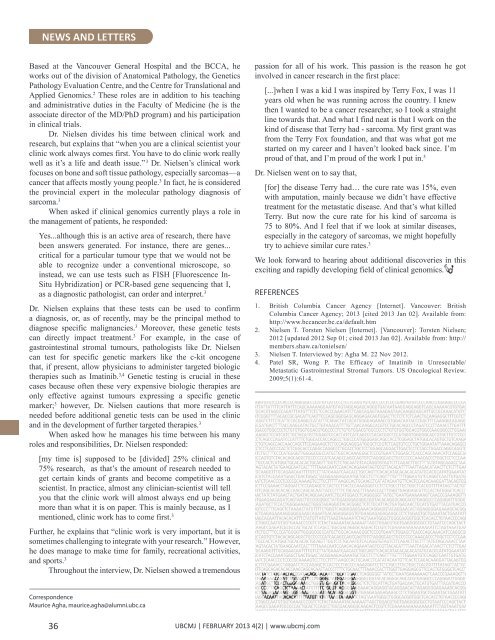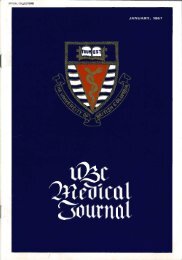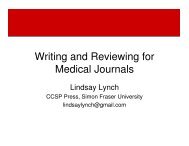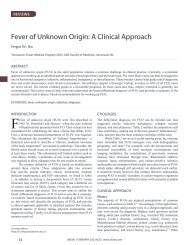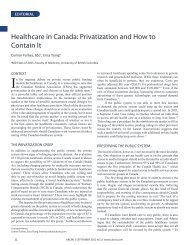Download full PDF - UBC Medical Journal
Download full PDF - UBC Medical Journal
Download full PDF - UBC Medical Journal
Create successful ePaper yourself
Turn your PDF publications into a flip-book with our unique Google optimized e-Paper software.
NEWS AND LETTERS<br />
Based at the Vancouver General Hospital and the BCCA, he<br />
works out of the division of Anatomical Pathology, the Genetics<br />
Pathology Evaluation Centre, and the Centre for Translational and<br />
Applied Genomics. 2 These roles are in addition to his teaching<br />
and administrative duties in the Faculty of Medicine (he is the<br />
associate director of the MD/PhD program) and his participation<br />
in clinical trials.<br />
Dr. Nielsen divides his time between clinical work and<br />
research, but explains that “when you are a clinical scientist your<br />
clinic work always comes first. You have to do clinic work really<br />
well as it’s a life and death issue.” 3 Dr. Nielsen’s clinical work<br />
focuses on bone and soft tissue pathology, especially sarcomas—a<br />
cancer that affects mostly young people. 3 In fact, he is considered<br />
the provincial expert in the molecular pathology diagnosis of<br />
sarcoma. 3<br />
When asked if clinical genomics currently plays a role in<br />
the management of patients, he responded:<br />
Yes...although this is an active area of research, there have<br />
been answers generated. For instance, there are genes...<br />
critical for a particular tumour type that we would not be<br />
able to recognize under a conventional microscope, so<br />
instead, we can use tests such as FISH [Fluorescence In-<br />
Situ Hybridization] or PCR-based gene sequencing that I,<br />
as a diagnostic pathologist, can order and interpret. 3<br />
Dr. Nielsen explains that these tests can be used to confirm<br />
a diagnosis, or, as of recently, may be the principal method to<br />
diagnose specific malignancies. 3 Moreover, these genetic tests<br />
can directly impact treatment. 3 For example, in the case of<br />
gastrointestinal stromal tumours, pathologists like Dr. Nielsen<br />
can test for specific genetic markers like the c-kit oncogene<br />
that, if present, allow physicians to administer targeted biologic<br />
therapies such as Imatinib. 3,4 Genetic testing is crucial in these<br />
cases because often these very expensive biologic therapies are<br />
only effective against tumours expressing a specific genetic<br />
marker; 3 however, Dr. Nielsen cautions that more research is<br />
needed before additional genetic tests can be used in the clinic<br />
and in the development of further targeted therapies. 3<br />
When asked how he manages his time between his many<br />
roles and responsibilities, Dr. Nielsen responded:<br />
[my time is] supposed to be [divided] 25% clinical and<br />
75% research, as that’s the amount of research needed to<br />
get certain kinds of grants and become competitive as a<br />
scientist. In practice, almost any clinician-scientist will tell<br />
you that the clinic work will almost always end up being<br />
more than what it is on paper. This is mainly because, as I<br />
mentioned, clinic work has to come first. 3<br />
Further, he explains that “clinic work is very important, but it is<br />
sometimes challenging to integrate with your research.” However,<br />
he does manage to make time for family, recreational activities,<br />
and sports. 3<br />
Throughout the interview, Dr. Nielsen showed a tremendous<br />
passion for all of his work. This passion is the reason he got<br />
involved in cancer research in the first place:<br />
[...]when I was a kid I was inspired by Terry Fox, I was 11<br />
years old when he was running across the country. I knew<br />
then I wanted to be a cancer researcher, so I took a straight<br />
line towards that. And what I find neat is that I work on the<br />
kind of disease that Terry had - sarcoma. My first grant was<br />
from the Terry Fox foundation, and that was what got me<br />
started on my career and I haven’t looked back since. I’m<br />
proud of that, and I’m proud of the work I put in. 3<br />
Dr. Nielsen went on to say that,<br />
[for] the disease Terry had… the cure rate was 15%, even<br />
with amputation, mainly because we didn’t have effective<br />
treatment for the metastatic disease. And that’s what killed<br />
Terry. But now the cure rate for his kind of sarcoma is<br />
75 to 80%. And I feel that if we look at similar diseases,<br />
especially in the category of sarcomas, we might hope<strong>full</strong>y<br />
try to achieve similar cure rates. 3<br />
We look forward to hearing about additional discoveries in this<br />
exciting and rapidly developing field of clinical genomics.<br />
REFERENCES<br />
1. British Columbia Cancer Agency [Internet]. Vancouver: British<br />
Columbia Cancer Agency; 2013 [cited 2013 Jan 02]. Available from:<br />
http://www.bccancer.bc.ca/default.htm<br />
2. Nielsen T. Torsten Nielsen [Internet]. [Vancouver]: Torsten Nielsen;<br />
2012 [updated 2012 Sep 01; cited 2013 Jan 02]. Available from: http://<br />
members.shaw.ca/tonielsen/<br />
3. Nielsen T. Interviewed by: Agha M. 22 Nov 2012.<br />
4. Patel SR, Wong P. The Efficacy of Imatinib in Unresectable/<br />
Metastatic Gastrointestinal Stromal Tumors. US Oncological Review.<br />
2009;5(1):61-4.<br />
Correspondence<br />
Maurice Agha, maurice.agha@alumni.ubc.ca<br />
36<br />
<strong>UBC</strong>MJ | FEBRUARY 2013 4(2) | www.ubcmj.com


